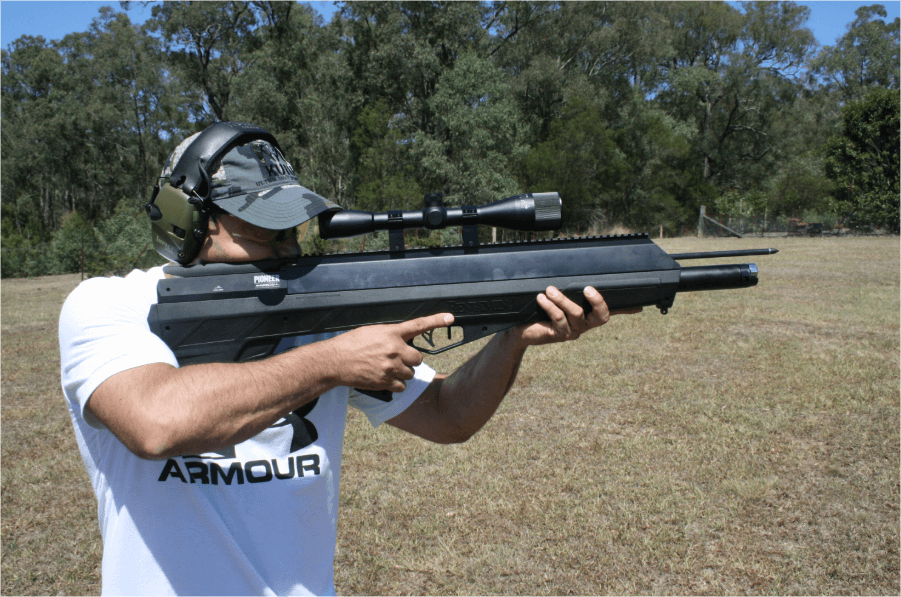📑Table of Contents:

In the world of archery, innovation is always at the forefront of the sport. Whether you’re a seasoned archer or a novice, advancements in technology have made significant changes in how we approach the bow and arrow. One such innovation that has captured attention is the Airbow. A powerful and unique tool, the Airbow blends the precision of archery with the speed and force of a firearm, providing archers with a completely new way to shoot arrows.
In this blog post, we’ll explore what the Airbow is, how it works, and why it’s considered a game-changer in the archery world.
What is the Airbow?
The Airbow is an innovative device that combines elements of both a bow and a firearm. It uses compressed air to propel arrows at incredibly high speeds, mimicking the launch of an arrow through a bowstring but without the need for physical tension from the archer. This unique design means that the Airbow is not a traditional bow—it’s a completely new way to shoot projectiles.
Developed as a tool to make archery more accessible to people with different physical abilities, the Airbow is easy to use and requires little physical exertion. Instead of drawing back a string, the Airbow works like a firearm, with a trigger mechanism that releases the arrow with precision. Whether you are a hunter, sports shooter, or simply a hobbyist, the Airbow offers a new approach to shooting arrows accurately and quickly.
How Does the Airbow Work?
The mechanics of the Airbow are quite different from traditional bows. Here’s how it works:
1. Compressed Air Propulsion
Unlike traditional bows, which rely on a drawn string for propulsion, the Airbow uses compressed air to launch the arrow. The device has a chamber that holds compressed air, which is released to push the arrow out at high speed. This process is much like a pneumatic gun, where air pressure is used to propel the projectile.
The compressed air is stored in a tank and released when the trigger is pulled, allowing the arrow to fly toward its target. The beauty of this system is that it doesn’t require any physical strength to draw the string. This makes it accessible to individuals who might struggle with the physical demands of traditional archery.
2. Arrow Design
The Airbow uses arrows that are specifically designed to withstand the pressure from the compressed air. These arrows are typically shorter and more durable than traditional archery arrows. This ensures that they can handle the high-speed launch without breaking or bending.
The broadheads of the arrows used with the Airbow are also designed to optimize accuracy and efficiency, ensuring that they perform at their best during hunting or target practice.
Advantages of the Airbow
The Airbow has many advantages, which have made it increasingly popular among archery enthusiasts and hunters alike. Here are a few key benefits:
1. Speed and Accuracy
One of the main advantages of the Airbow is the speed at which it can shoot arrows. The compressed air system allows for a quick release of the arrow, significantly reducing the amount of time it takes to reach the target. This quickness translates to improved accuracy, especially when shooting at moving targets.
For hunters, this means a more efficient kill shot, as the arrow can hit its mark with great speed and precision. For sports archers, the quickness of the Airbow can lead to better overall performance, especially in competitive settings where time is of the essence.
2. Ease of Use
Unlike traditional bows that require the archer to draw the string, the Airbow is much easier to use. All you need to do is load the arrow, aim, and pull the trigger. There’s no need to develop the strength and technique to pull back a heavy string, which makes the Airbow perfect for individuals who may have physical limitations or those who simply prefer a more straightforward approach.
Because it operates like a firearm, many users find the Airbow to be more intuitive than traditional archery, especially for those familiar with guns. This makes the Airbow an ideal tool for those who want to enjoy archery without the steep learning curve.
3. Minimal Physical Strain
Since the Airbow doesn’t require the archer to draw back a bowstring, it’s much easier on the body than traditional archery. This is especially beneficial for people with joint issues or limited strength, as they can still enjoy archery without straining their muscles.
This advantage makes the Airbow an excellent choice for people of all ages and abilities. It opens up archery to a broader audience and allows everyone to experience the thrill of shooting arrows with precision and power.
Applications of the Airbow
The versatility of the Airbow makes it suitable for various applications, from recreational archery to hunting. Let’s explore some of the primary uses of the Airbow:
1. Hunting
The Airbow has found a particular niche in hunting. Many hunters prefer the Airbow because it offers the speed and power of a firearm, combined with the stealth and accuracy of a bow. It allows hunters to take down game with minimal noise and a quick, precise shot, making it especially useful for large game hunting.
The Airbow’s ability to launch arrows with great force also means that it can be used for both small and large game. Whether hunting for deer, boar, or even larger animals, the Airbow provides a reliable, efficient tool for hunters.
2. Sports and Competitive Archery
For competitive archers, the Airbow offers a new way to practice and compete. The speed and accuracy of the Airbow make it an excellent choice for target shooting, especially in timed events where precision and quick reactions are essential. While it’s still relatively new to the world of archery competitions, it has already started making waves, with some tournaments adopting the Airbow as a standard tool.
3. Recreational Archery
For those who simply enjoy archery as a hobby, the Airbow offers a fun and unique experience. It’s easy to learn and use, making it a great option for beginners. The Airbow presents a unique challenge compared to traditional bows, enabling shooters to refine their skills and assess their accuracy in a novel manner.
Airbow vs Traditional Bows and Crossbows
The Airbow stands out for its combination of speed, power, and ease of use. Unlike traditional recurve or compound bows that require significant upper body strength and practice to master, the Airbow uses compressed air to launch arrows with extreme precision. Compared to crossbows, Airbows offer faster reload times and reduced mechanical complexity. In terms of maintenance, the Airbow has fewer moving parts, making upkeep easier. For accuracy, Airbows generally provide tighter groupings at long ranges due to consistent air pressure, while traditional archery tools require greater skill and muscle control.
Legal and Ethical Considerations
The legal status of Airbows varies widely. In the United States, some states classify them as air guns, allowing their use in hunting during firearm seasons, while others treat them like archery equipment or prohibit them altogether. Internationally, regulations differ significantly, with some countries banning their use for hunting due to concerns about fairness and sportsmanship. Ethical debates center around whether the ease and power of the Airbow give hunters an unfair advantage, diminishing the challenge and respect traditionally associated with bowhunting.
Popular Airbow Models and Brands
One of the most well-known Airbow models is the Benjamin Pioneer Airbow by Crosman. This model has gained attention for its lightweight design, high accuracy, and ease of use. Other emerging brands and models continue to innovate, offering quieter shooting, modular designs, and enhanced safety features. These manufacturers are pushing the boundaries of what’s possible in modern archery and hunting.
User Experience and Testimonials
Many users praise the Airbow for its accuracy and minimal recoil. Hunters report clean, ethical kills due to the weapon’s precision and power. Recreational users often describe it as a fun and intuitive option that bridges the gap between archery and shooting sports. Some testimonials highlight how it enables individuals with physical limitations to enjoy archery again.
Safety Features and Handling Tips
Airbows are designed with multiple safety mechanisms, including trigger safeties, pressure release valves, and safety levers. Users are advised to always wear eye protection and ensure proper maintenance of the air tank. Handling tips include regular pressure checks, safe loading procedures, and practicing in controlled environments before taking the Airbow into the field.
Cost and Accessibility
Airbows are priced between $700 $1,500, depending on the model and included accessories. Packages often come with a pump or tank, arrows, and a scope. While the initial cost is higher than that of traditional bows, the ease of use and long-term reliability may justify the investment for many. However, due to varying regulations and availability, potential buyers should research local laws before purchasing.
The Future of the Airbow
As the popularity of the Airbow continues to grow, it’s clear that this innovative tool will have a lasting impact on the world of archery and hunting. Its combination of speed, accuracy, and ease of use has made it an attractive option for both seasoned professionals and newcomers alike.
With advancements in technology, the Airbow will likely continue to evolve, becoming even more efficient and user-friendly. Whether used for hunting, sport, or recreation, the Airbow is poised to redefine the way we think about archery.

Conclusion: Why the Airbow is a Game-Changer
The Airbow is a revolutionary product that combines the best features of archery and firearms, offering a powerful and accessible alternative to traditional bows. With its speed, accuracy, and minimal physical demand, the Airbow has quickly gained popularity among archers and hunters alike.
Whether you’re looking for a tool that makes archery easier to learn, a more efficient hunting weapon, or a fun and unique experience, the Airbow is the perfect choice.





